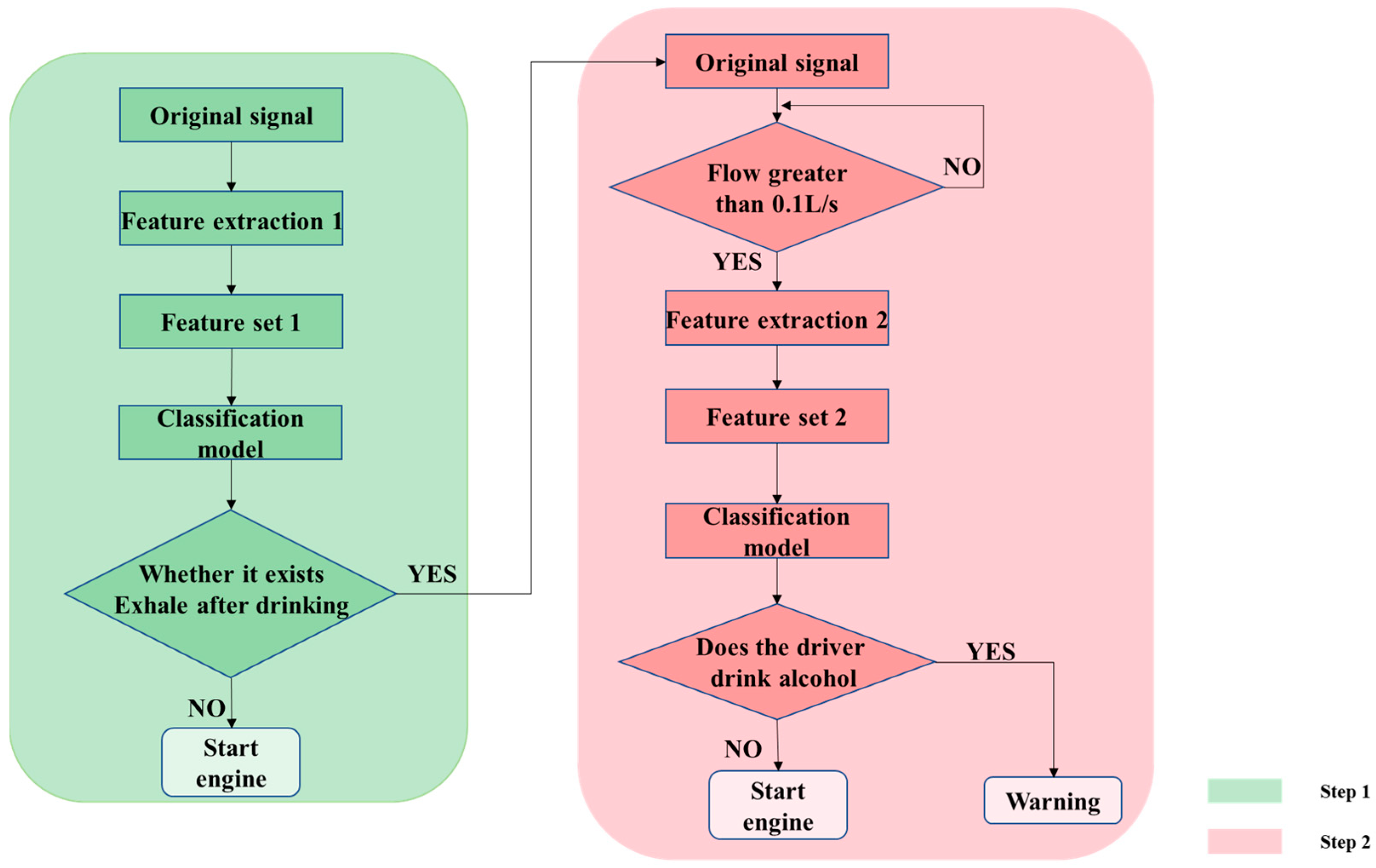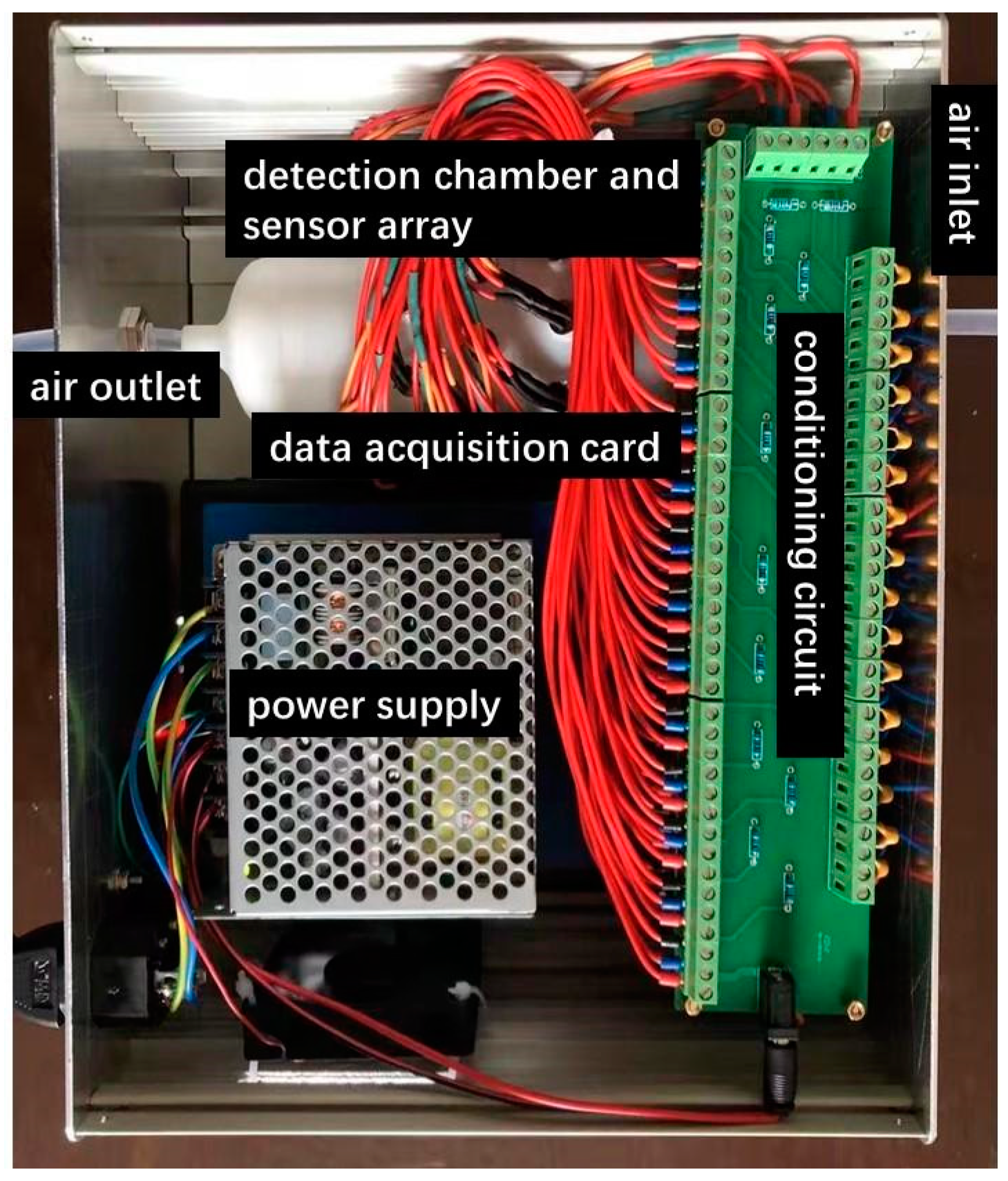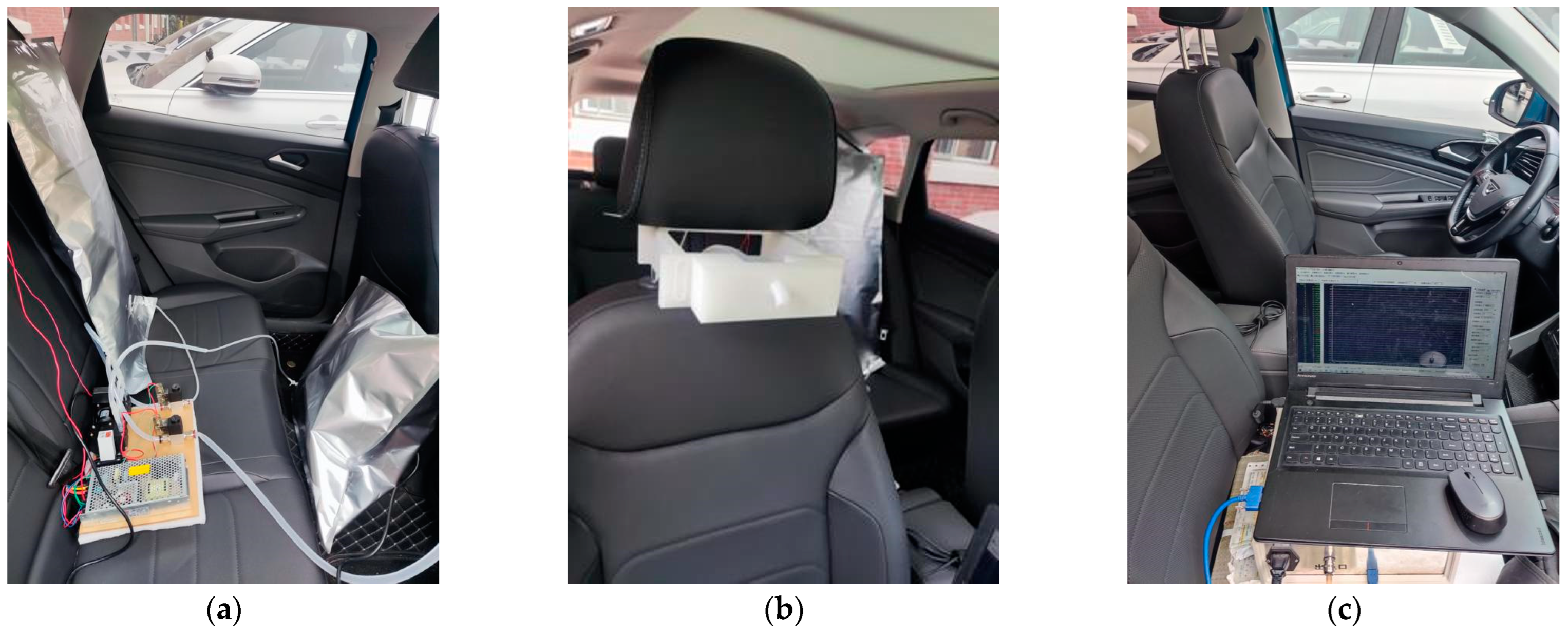1. Introduction
Drunk driving is a great hazard to road traffic safety. According to the World Health Organization, 40% of road traffic accidents are attributed to drivers under the influence of alcohol, which is the fifth leading cause of death on the road [
1]. In the first half of 2019 alone, China investigated and dealt with 901,000 cases of driving under the influence (DUI), including 177,000 cases of drunk driving and 1525 traffic accidents caused by DUI, resulting in 1674 deaths [
2]. At the same time, with the rising number of car drivers, the shared car industry also welcomes good development opportunities. The emergence and vigorous development of shared cars have brought more choices and convenience to people’s travel, but the regulatory norms have not been improved. In the case of the shared car accident, the imperfection of the identification system repeatedly makes the leasing company the subject of compensation liability for failing to fulfill the obligation of prudent supervision. Therefore, shared car companies have a strong desire to prevent drunk driving [
3].
Due to the hazards of drunk driving, it has been listed as an illegal act in all countries. In recent years, countries have taken various forms of preventive measures against drunk driving. The most common is that police officers conduct traffic inspections through handheld breath alcohol detection devices, but this method seriously wastes police resources and will cause traffic congestion in the process of traffic law enforcement. In addition, according to the personal constitution and alcohol consumption, alcohol may still be found in the blood after drinking for 18 h [
4], which has potential safety hazards in driving behavior, so drivers also need instruments with accurate judgment results to detect their own state. All in all, it is self-evident that the research and development of an onboard drunk driving detection system are necessary for shared car companies, traffic management departments, and ordinary drivers.
For the onboard drunk driving detection system, we conducted a literature survey. Existing devices at home and abroad that can be applied to onboard drunk driving detection of shared vehicles include an ignition interlock device using fuel cell sensors [
5], an image recognition drunk driving detection system based on driver facial feature detection [
6], and a driver alcohol safety detection system based on breathing and touch using infrared optical sensors (DADSS) [
7]. The alcohol concentration in the breath is an important indicator to judge whether a driver is drunk while driving. However, the traditional onboard ignition interlock device requires the driver to actively blow air, which will cause unnecessary trouble to drivers who have not drunk alcohol. For the onboard alcohol driving detection system based on the alcohol concentration of gas in the cabin, other sources of alcohol gas in the cabin will affect the judgment of alcohol driving. Other sources include drunken breath from passengers and accidentally spilled alcohol. The breath-based detection method in DADSS eliminates the interference of passengers’ exhalation after drinking by placing sensors in multiple positions, but it is powerless to interfere with alcohol-containing volatile gases such as the volatile gases of spilled wine. Tissue-spectrum recognition can eliminate the interference of foreign alcohol gases, but it is possible to be replaced by fellow passengers, which is still under continuous research and development. Using the image to recognize facial features is a good method to detect drunk driving, but the introduction of cameras will cause concerns about privacy issues, and the data must be stored safely [
4]. In general, it is still a huge challenge to accurately detect whether the driver is drunk in the cabin environment.
The electronic nose used in the drunk driving detection system designed in this paper is a system that recognizes single or complex components of gas or odor by a specific sensor array combined with the corresponding pattern recognition algorithm [
8]. In recent decades, researchers have applied the electronic nose system to many fields, such as food detection, air quality monitoring, wound bacteria detection, disease detection, and fire detection [
9,
10,
11,
12,
13,
14], and achieved good results. For example, in terms of odor detection in confined spaces, the electronic nose has been used in the Mir space station to monitor variations in air quality within the station [
15]. In terms of odor interference, an electronic nose based on the BP-ANN model has been successfully utilized to conduct semi-quantitative, real-time, and anti-interference detection of CO and CH
4 in contexts of H
2 and CH
2O interference [
16]. Exhaled gas after drinking is a kind of mixed gas, and there is usually interfering gas in the cabin, so the electronic nose is a suitable device for onboard drunk driving detection.
In addition to the consideration of the detection effect, the user’s experience and installation cost should also be taken into account in the design of the onboard alcohol driving detection system for shared vehicles. To avoid the problem that the traditional onboard ignition interlock device needs each driver to blow air for detection and the cost problem caused by the breath-based DADSS needing to install sensors at multiple locations, we propose a two-step drunk driving detection framework based on the electronic nose. The first step is to detect whether there is gas exhaled after drinking in the cabin to determine whether someone in the vehicle has drunk alcohol. Then, when it is determined that someone has drunk alcohol, the second step is to let the driver actively exhale into the electronic nose to judge whether the driver has drunk alcohol. This design reduces the requirements for the driver to a certain extent and ensures the user’s experience. At the same time, the installation position of the sensor is reduced, and the cost is saved.
In addition to proposing the two-step drunk driving detection framework, we also optimized the sensor array. The array composed of multiple sensors is the kernel component of the electronic nose. With the continuous development of material research, various gas-sensing materials are gradually developed, such as graphene [
17], carbon nanotubes [
18], conductive polymers [
19], and metal oxides [
20]. Among them, the metal oxide semiconductor (MOS) gas sensor has been widely used in the electronic nose, mainly because the MOS gas sensor has a fast response to the target gas, a long service life, mature production technology, a low price, and so on [
21]. A remarkable feature of the array of MOS sensors in the electronic nose is cross-sensitivity, so the redundancy of the sensor array is inevitable. Sensor array optimization can remove redundant information, speed up data processing, and make the electronic nose use less cost and space, which helps the electronic nose drunk driving detection system be widely used in shared cars.
This paper presents a kind of electronic nose system for drunk driving detection based on a MOS sensor array, which can be widely used in shared cars. The detection system applies a two-step alcohol driving detection framework proposed by us, which reduces interference to the driver and ensures the driver’s user experience. The random forest algorithm is used to optimize the original sensor array, which reduces the cost and volume of the system. The optimal sampling time and detection algorithm are selected by time-slicing the data to ensure detection efficiency and accuracy.
In the second part of this paper, we introduce our two-step detection framework in detail. The third part introduces the simulated exhalation device, electronic nose, test procedure, and optimization method of the sensor array. The fourth part describes the experimental outcomes. The last part provides a conclusion summarizing the research conducted in this paper and discusses the existing problems and future research directions.
2. Two-Step Drunk Driving Detection Framework
2.1. Framework Introduction
Considering the driver’s experience, onboard drunk driving detection should avoid interference with the driver as much as possible. Therefore, we designed a new drunk driving detection framework. The framework includes two steps. The first step is to detect whether there is gas exhaled after drinking in the cabin without the driver’s active cooperation. If not, drive normally. Second, when the gas exhaled after drinking is detected in the cabin, let the driver actively blow into the air inlet of the electronic nose to collect information and judge whether the driver is drunk. See
Figure 1 for the schematic diagram of the frame.
2.2. Step 1
In the first step, the purpose of electronic nose detection is to judge whether there is gas exhaled after drinking in the cabin and, therefore, whether someone is drunk. First, collect the original signal from the electronic nose for feature extraction 1 to obtain feature set 1, and then use the trained classification model to judge. If there is no gas exhaled after drinking, start the engine; otherwise, enter the second step.
The classification algorithm was selected from the K-Nearest Neighbor (KNN), Support Vector Machine (SVM), and Random Forest (RF) by comparing the model classification accuracy [
22,
23,
24]. The following is a brief introduction to the KNN, SVM, and RF.
- (1)
KNN
KNN is a supervised learning algorithm, so it is necessary to provide a training set of data with known tags. When classifying, KNN first calculates the distance between the features of the data to be classified and the features of the known data in the training set and arranges the training set data in ascending order according to the calculated distance. Find the top K training set data and count the frequency of all kinds of tags; the label with the most occurrences is the category of the data to be classified.
- (2)
SVM
SVM is also a supervised learning algorithm. Its basic idea is to find the hyperplane that can separate two types of sample data with the largest distance on the feature space of the sample data set, and it is mainly used for binary classification problems. SVM can be expressed mathematically as the problem of solving convex quadratic programming. Because many data are, in reality, nonlinear, SVM introduces the kernel function. Common kernel functions include the RBF kernel and the Laplace kernel. This paper used the RBF kernel.
- (3)
RF
Random forest is a statistical learning theory method based on the decision tree. In addition to expanding the tree into a forest, the random forest algorithm also adds random attributes to the training process of the model. Its randomness is reflected in two aspects. First, for each decision tree in the random forest, its training set data is obtained by randomly extracting N samples from the original training set. Second, when the nodes of the tree need to be split, m features (m is less than the total number of features) are randomly selected from the features contained in each sample of data, and the best features are selected from them to segment the nodes. The addition of randomness improves the ability of the random forest algorithm to resist overfitting and noise. For the classification task, the result of the random forest algorithm adopts the principle that the minority is subordinate to the majority and is determined by the vote of the base classifier.
2.3. Step 2
In the case that the exhaled breath after drinking is detected, the driver still has two possible states: one is not drunk, the exhaled breath after drinking is exhaled by the passenger, and the other is drunk. Further detection is required. In consideration of the numerous interferences that may exist in the cabin, the information is collected by letting the driver actively blow air to improve the judgment accuracy of the detection system. In a practical application, in order to know the timing of starting sampling in the second step, a flowmeter can be set at the blowing port to monitor the instantaneous flow.
When there is gas exhaled after drinking in the cabin, the drunk driver detection system starts to monitor the instantaneous flow of the flowmeter. When the instantaneous flow is greater than 0.1 L/s [
25], the system starts to record the data obtained by the sensor array. Then, feature extraction 2 is performed on the obtained data to obtain feature set 2. Finally, the trained classification model is used for judgment. If the driver is not drunk, the engine could be started; otherwise, a warning will be given to the driver.
5. Conclusions
The realization of onboard drunk driving detection plays an important role in improving road traffic safety, but the shared car cabin environment is complex and changeable, and conventional technology has encountered some difficulties in accurately judging the driver’s drunk driving situation. In this study, a rapid detection system of the vehicle’s electronic nose for drunk driving based on sensor array optimization and a two-step framework were proposed. It can judge whether there is a drinker in the car within 5 s, and the accuracy rate can reach 99.44%. For the situation where there is a drinker in the car, it can also judge whether the driver is drinking within 10 s, with 100% accuracy. Compared with the traditional onboard ignition interlock device, the drunk driving detection system designed in this paper does not require the driver to actively blow air every time, so it has little interference with the driver of the vehicle without drinking personnel. The sensor array of the system is composed of 9 MOS sensors, so the vehicle drunk driving detection system designed in this paper has a low cost and can be widely used in the shared automobile industry.
However, the system has only verified the feasibility of the electronic nose as an onboard drunk driving detection system, and there are still difficulties in its application. Firstly, shared cars are distributed over a wide area, and the climate environment is very different. The MOS Sensor Array, which serves as the central element of the Electronic Nose, is susceptible to changes in the temperature and humidity of its surroundings. Therefore, before the system is popularized, it is inevitable that it should effectively solve the influence of temperature and humidity. Secondly, the simulated exhalation device is still very rough and needs further optimization to make it closer to the real breathing situation. Finally, at present, what we are making is only a prototype, and it is necessary to redesign its circuit to make it more suitable for vehicles. These are the things we need to do next.










